Abstract
Previous studies have implicated the DE-1 (-111/-106) and alpha A-CRYBP1 (-66/-57) sites for activity of the mouse alpha A-crystallin promoter in transiently transfected lens cells. Here we have used the bacterial chloramphenicol acetyltransferase (CAT) reporter gene to test the functional importance of the putative DE-1 and alpha A-CRYBP1 regulatory elements by site-specific and deletion mutagenesis in stably transformed alpha TN4-1 lens cells and in transgenic mice. FVB/N and C57BL/6 x SJL F2 hybrid transgenic mice were assayed for CAT activity in the lens, heart, lung, kidney, spleen, liver, cerebrum, and muscle. F0, F1, and F2 mice from multiple lines carrying single mutations of the DE-1 or alpha A-CRYBP1 sites showed high levels of CAT activity in the lens, but not in any of the non-lens tissues. By contrast, despite activity of the wild-type promoter, none of the mutant promoter/CAT constructs were active in the transiently transfected and stably transformed lens cells. The mice carrying transgenes with either site-specific mutations in both the DE-1 and alpha A-CRYBP1 sites or a deletion of the entire DE-1 and part of the alpha A-CRYBP1 site (-60/+46) fused to the CAT gene did not exhibit CAT activity above background in any of the tissues examined, including the lens. Our results thus indicate that the DE-1 and alpha A-CRYBP1 sites are functionally redundant in transgenic mice. Moreover, the present data coupled with previous transfection and transgenic mouse experiments suggest that this functional redundancy is confined to lens expression within the mouse and is not evident in transiently transfected and stably transformed lens cells, making the cultured lens cells sensitive indicators of functional elements of crystallin genes.
Full text
PDF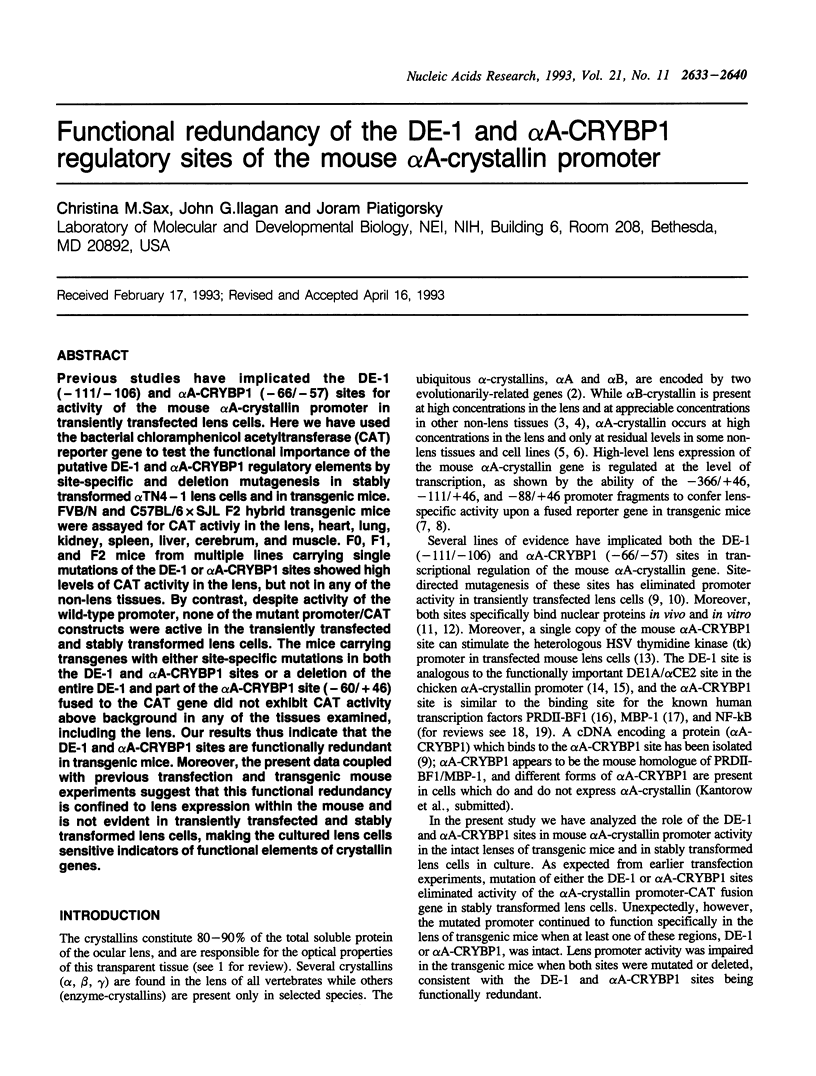
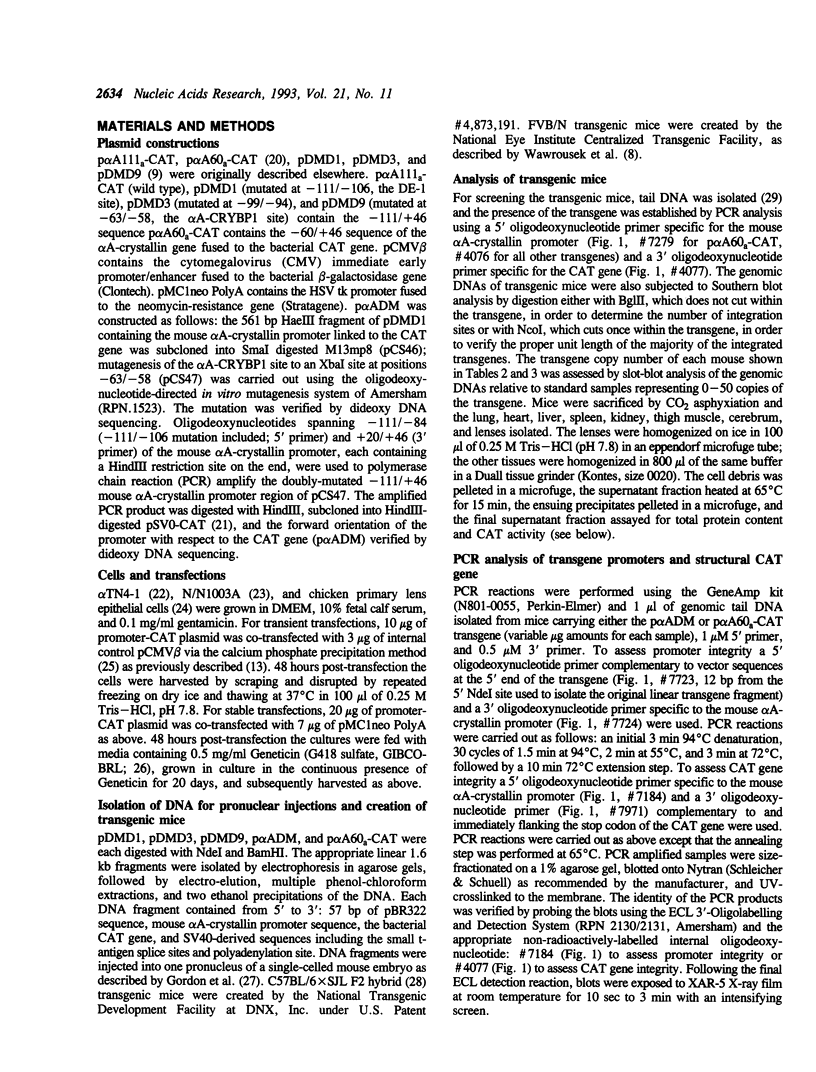
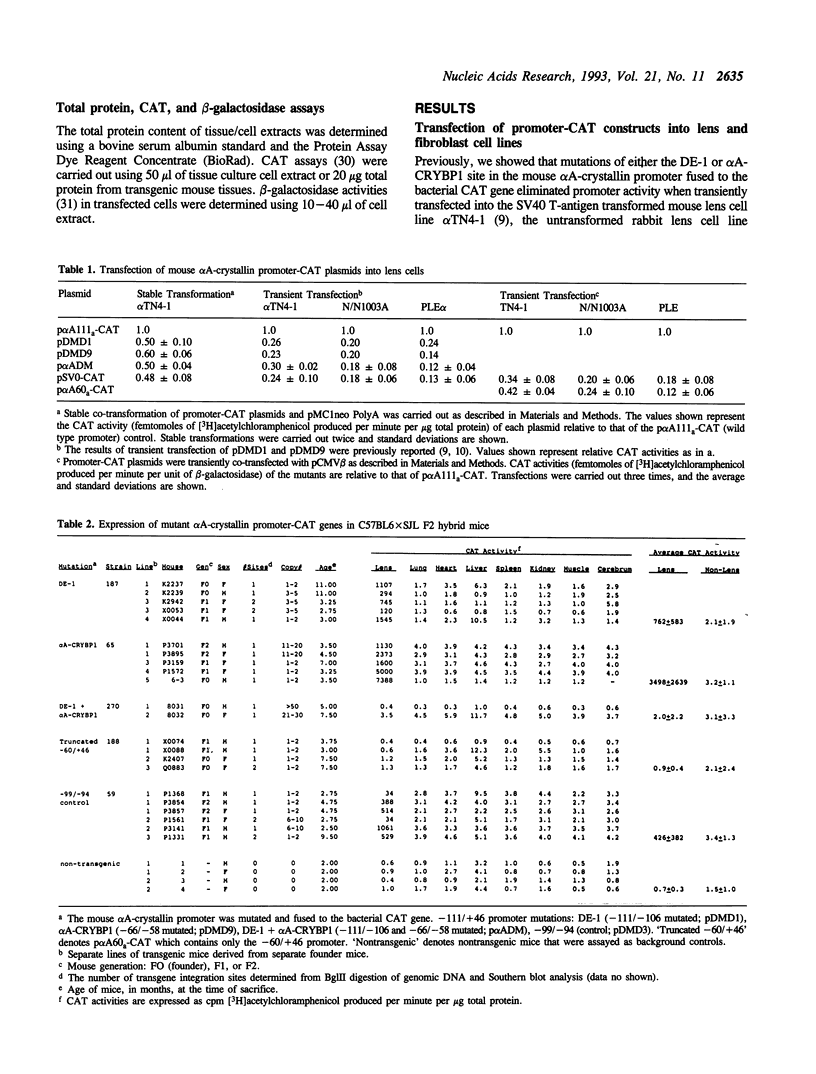
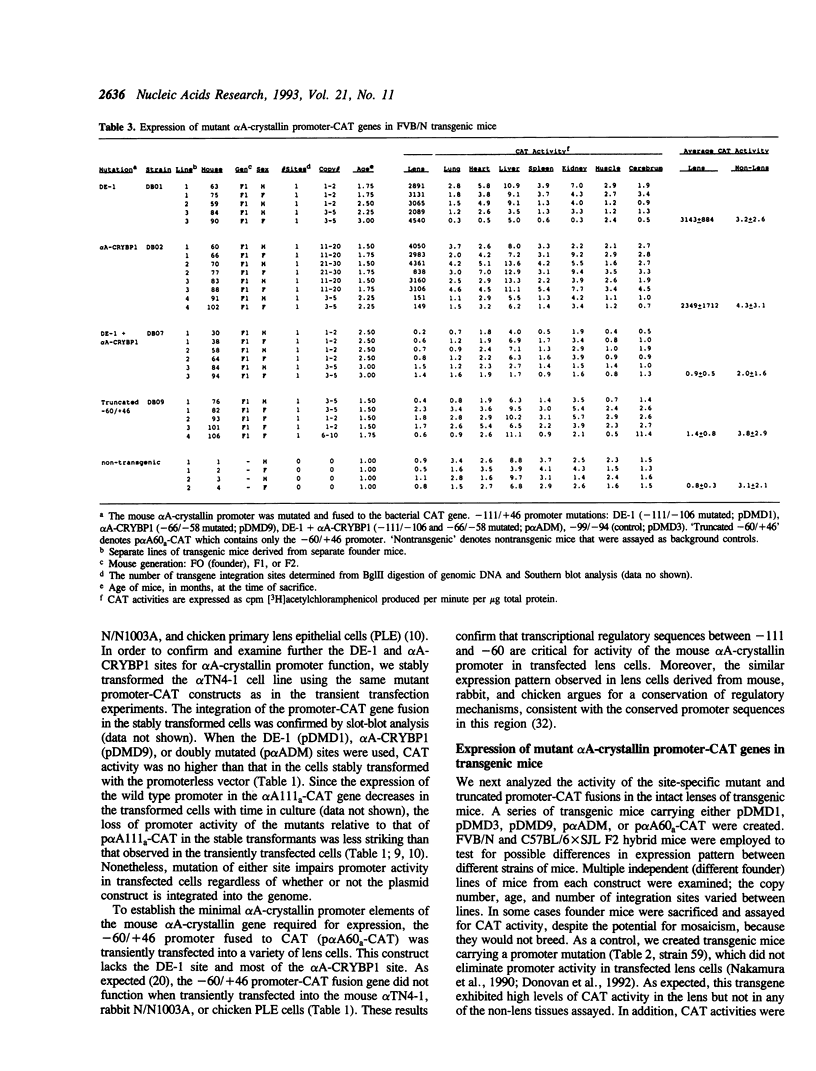
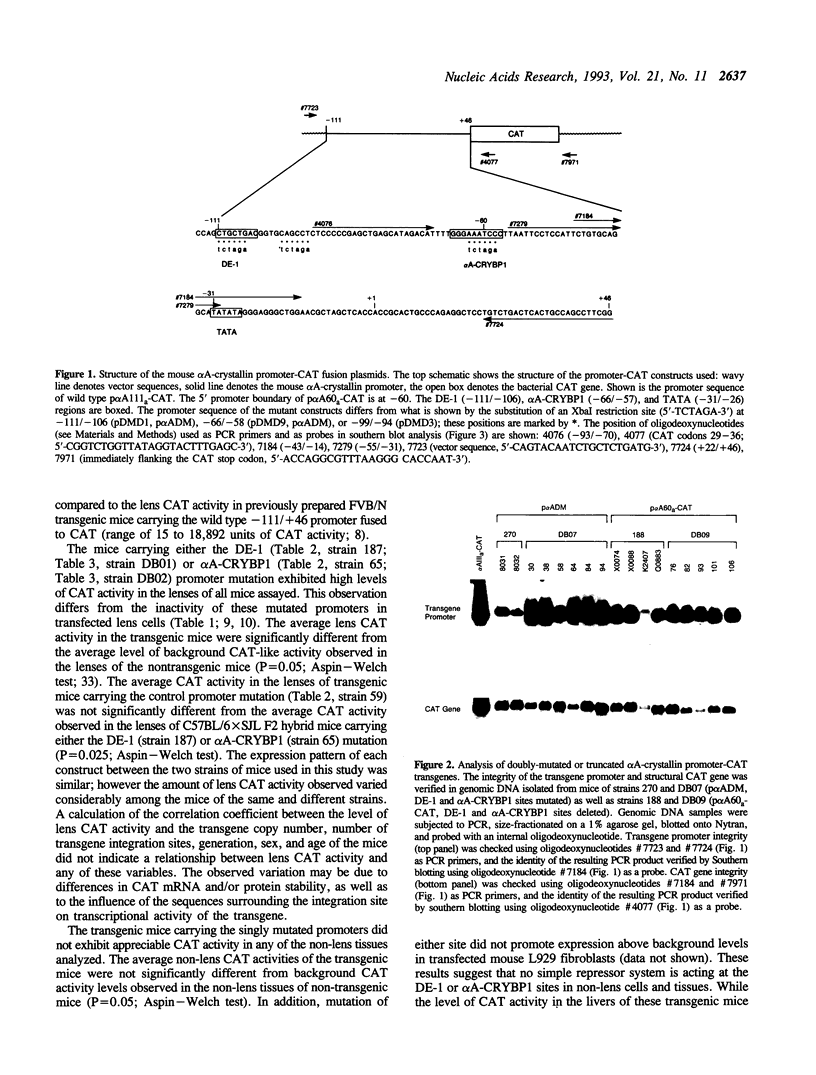
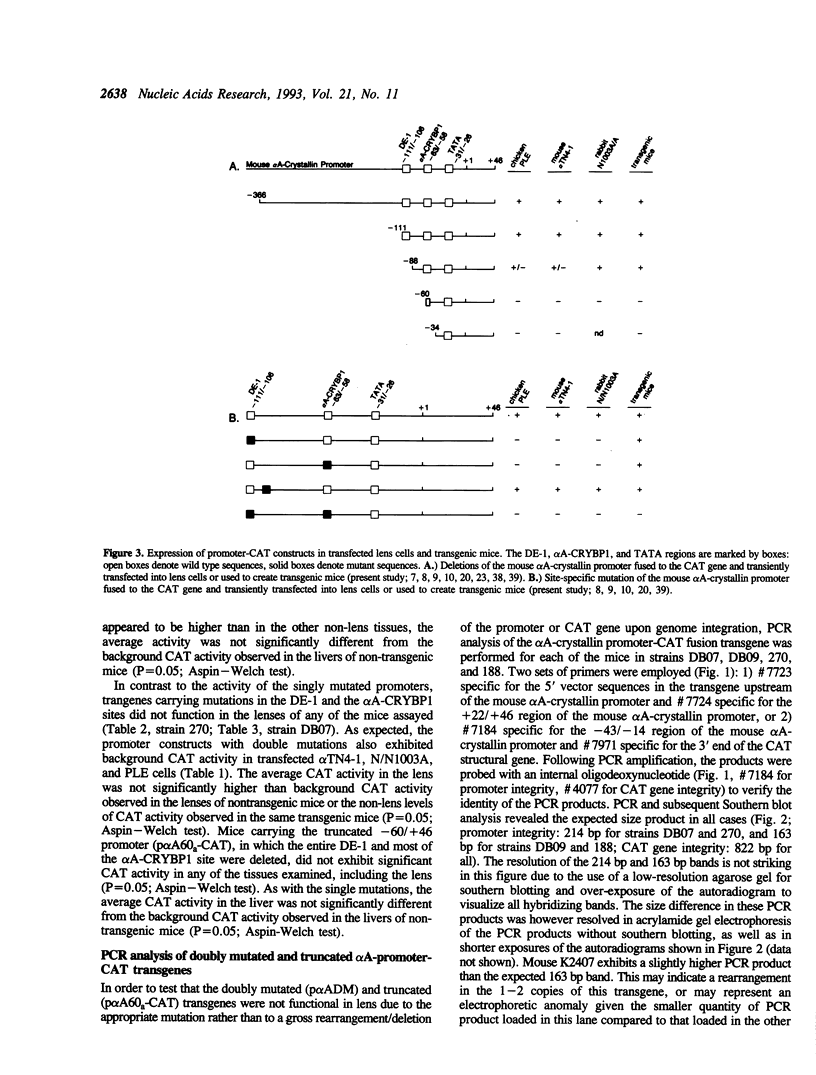
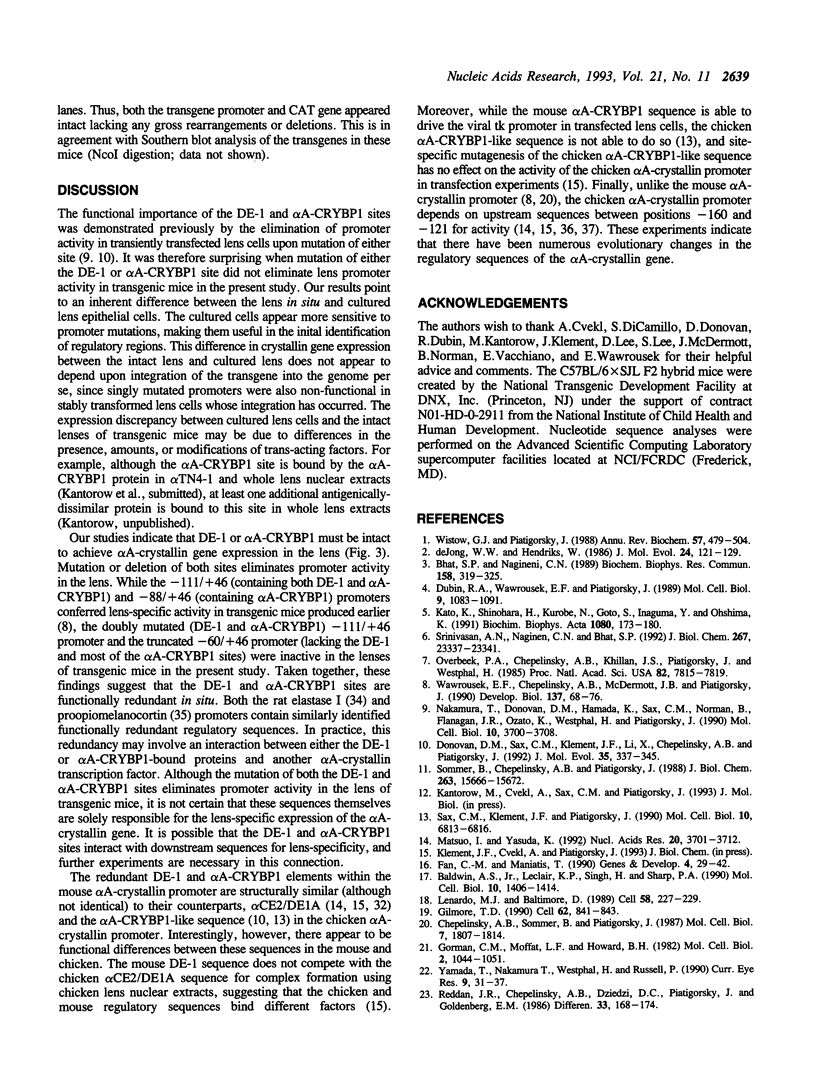
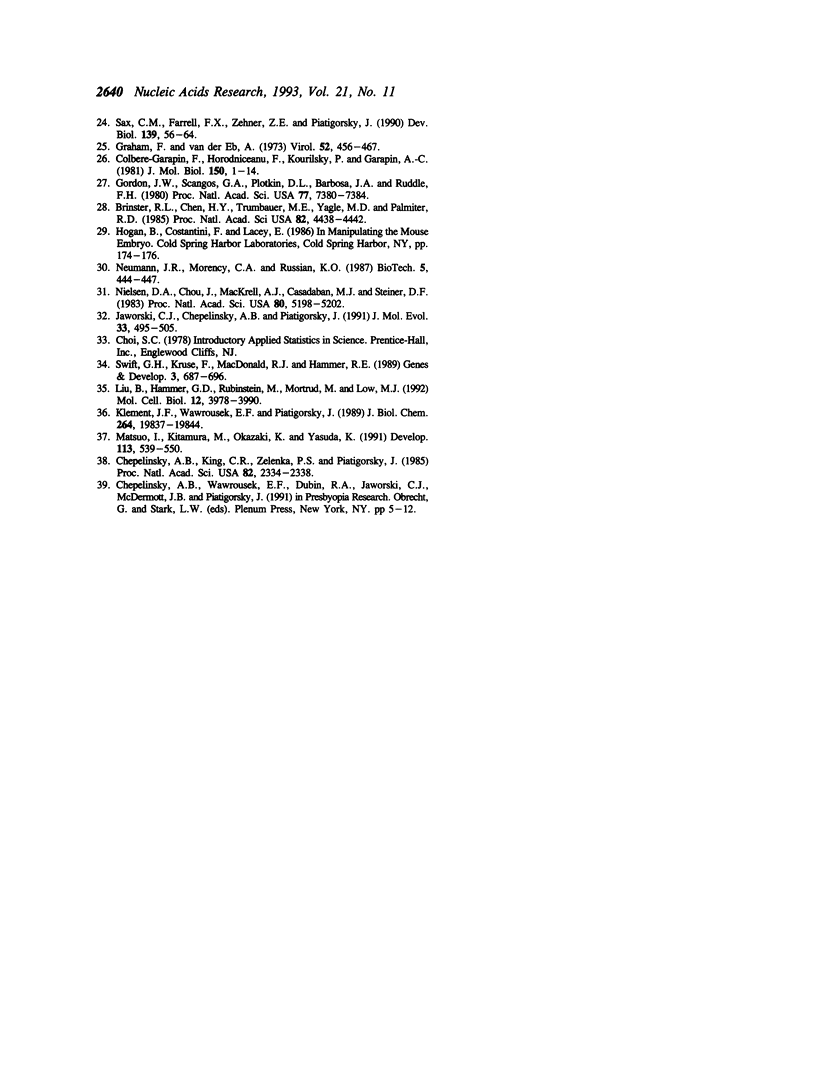
Images in this article
Selected References
These references are in PubMed. This may not be the complete list of references from this article.
- Baldwin A. S., Jr, LeClair K. P., Singh H., Sharp P. A. A large protein containing zinc finger domains binds to related sequence elements in the enhancers of the class I major histocompatibility complex and kappa immunoglobulin genes. Mol Cell Biol. 1990 Apr;10(4):1406–1414. doi: 10.1128/mcb.10.4.1406. [DOI] [PMC free article] [PubMed] [Google Scholar]
- Bhat S. P., Nagineni C. N. alpha B subunit of lens-specific protein alpha-crystallin is present in other ocular and non-ocular tissues. Biochem Biophys Res Commun. 1989 Jan 16;158(1):319–325. doi: 10.1016/s0006-291x(89)80215-3. [DOI] [PubMed] [Google Scholar]
- Brinster R. L., Chen H. Y., Trumbauer M. E., Yagle M. K., Palmiter R. D. Factors affecting the efficiency of introducing foreign DNA into mice by microinjecting eggs. Proc Natl Acad Sci U S A. 1985 Jul;82(13):4438–4442. doi: 10.1073/pnas.82.13.4438. [DOI] [PMC free article] [PubMed] [Google Scholar]
- Chepelinsky A. B., King C. R., Zelenka P. S., Piatigorsky J. Lens-specific expression of the chloramphenicol acetyltransferase gene promoted by 5' flanking sequences of the murine alpha A-crystallin gene in explanted chicken lens epithelia. Proc Natl Acad Sci U S A. 1985 Apr;82(8):2334–2338. doi: 10.1073/pnas.82.8.2334. [DOI] [PMC free article] [PubMed] [Google Scholar]
- Chepelinsky A. B., Sommer B., Piatigorsky J. Interaction between two different regulatory elements activates the murine alpha A-crystallin gene promoter in explanted lens epithelia. Mol Cell Biol. 1987 May;7(5):1807–1814. doi: 10.1128/mcb.7.5.1807. [DOI] [PMC free article] [PubMed] [Google Scholar]
- Colbère-Garapin F., Horodniceanu F., Kourilsky P., Garapin A. C. A new dominant hybrid selective marker for higher eukaryotic cells. J Mol Biol. 1981 Jul 25;150(1):1–14. doi: 10.1016/0022-2836(81)90321-1. [DOI] [PubMed] [Google Scholar]
- Donovan D. M., Sax C. M., Klement J. F., Li X., Chepelinsky A. B., Piatigorsky J. Conservation of mouse alpha A-crystallin promoter activity in chicken lens epithelial cells. J Mol Evol. 1992 Oct;35(4):337–345. doi: 10.1007/BF00161171. [DOI] [PubMed] [Google Scholar]
- Dubin R. A., Wawrousek E. F., Piatigorsky J. Expression of the murine alpha B-crystallin gene is not restricted to the lens. Mol Cell Biol. 1989 Mar;9(3):1083–1091. doi: 10.1128/mcb.9.3.1083. [DOI] [PMC free article] [PubMed] [Google Scholar]
- Fan C. M., Maniatis T. A DNA-binding protein containing two widely separated zinc finger motifs that recognize the same DNA sequence. Genes Dev. 1990 Jan;4(1):29–42. doi: 10.1101/gad.4.1.29. [DOI] [PubMed] [Google Scholar]
- Gilmore T. D. NF-kappa B, KBF1, dorsal, and related matters. Cell. 1990 Sep 7;62(5):841–843. doi: 10.1016/0092-8674(90)90257-f. [DOI] [PubMed] [Google Scholar]
- Gordon J. W., Scangos G. A., Plotkin D. J., Barbosa J. A., Ruddle F. H. Genetic transformation of mouse embryos by microinjection of purified DNA. Proc Natl Acad Sci U S A. 1980 Dec;77(12):7380–7384. doi: 10.1073/pnas.77.12.7380. [DOI] [PMC free article] [PubMed] [Google Scholar]
- Gorman C. M., Moffat L. F., Howard B. H. Recombinant genomes which express chloramphenicol acetyltransferase in mammalian cells. Mol Cell Biol. 1982 Sep;2(9):1044–1051. doi: 10.1128/mcb.2.9.1044. [DOI] [PMC free article] [PubMed] [Google Scholar]
- Graham F. L., van der Eb A. J. A new technique for the assay of infectivity of human adenovirus 5 DNA. Virology. 1973 Apr;52(2):456–467. doi: 10.1016/0042-6822(73)90341-3. [DOI] [PubMed] [Google Scholar]
- Jaworski C. J., Chepelinsky A. B., Piatigorsky J. The alpha A-crystallin gene: conserved features of the 5'-flanking regions in human, mouse, and chicken. J Mol Evol. 1991 Dec;33(6):495–505. doi: 10.1007/BF02102802. [DOI] [PubMed] [Google Scholar]
- Kato K., Shinohara H., Kurobe N., Goto S., Inaguma Y., Ohshima K. Immunoreactive alpha A crystallin in rat non-lenticular tissues detected with a sensitive immunoassay method. Biochim Biophys Acta. 1991 Oct 25;1080(2):173–180. doi: 10.1016/0167-4838(91)90146-q. [DOI] [PubMed] [Google Scholar]
- Klement J. F., Wawrousek E. F., Piatigorsky J. Tissue-specific expression of the chicken alpha A-crystallin gene in cultured lens epithelia and transgenic mice. J Biol Chem. 1989 Nov 25;264(33):19837–19844. [PubMed] [Google Scholar]
- Lenardo M. J., Baltimore D. NF-kappa B: a pleiotropic mediator of inducible and tissue-specific gene control. Cell. 1989 Jul 28;58(2):227–229. doi: 10.1016/0092-8674(89)90833-7. [DOI] [PubMed] [Google Scholar]
- Liu B., Hammer G. D., Rubinstein M., Mortrud M., Low M. J. Identification of DNA elements cooperatively activating proopiomelanocortin gene expression in the pituitary glands of transgenic mice. Mol Cell Biol. 1992 Sep;12(9):3978–3990. doi: 10.1128/mcb.12.9.3978. [DOI] [PMC free article] [PubMed] [Google Scholar]
- Matsuo I., Kitamura M., Okazaki K., Yasuda K. Binding of a factor to an enhancer element responsible for the tissue-specific expression of the chicken alpha A-crystallin gene. Development. 1991 Oct;113(2):539–550. doi: 10.1242/dev.113.2.539. [DOI] [PubMed] [Google Scholar]
- Matsuo I., Yasuda K. The cooperative interaction between two motifs of an enhancer element of the chicken alpha A-crystallin gene, alpha CE1 and alpha CE2, confers lens-specific expression. Nucleic Acids Res. 1992 Jul 25;20(14):3701–3712. doi: 10.1093/nar/20.14.3701. [DOI] [PMC free article] [PubMed] [Google Scholar]
- Nakamura T., Donovan D. M., Hamada K., Sax C. M., Norman B., Flanagan J. R., Ozato K., Westphal H., Piatigorsky J. Regulation of the mouse alpha A-crystallin gene: isolation of a cDNA encoding a protein that binds to a cis sequence motif shared with the major histocompatibility complex class I gene and other genes. Mol Cell Biol. 1990 Jul;10(7):3700–3708. doi: 10.1128/mcb.10.7.3700. [DOI] [PMC free article] [PubMed] [Google Scholar]
- Nielsen D. A., Chou J., MacKrell A. J., Casadaban M. J., Steiner D. F. Expression of a preproinsulin-beta-galactosidase gene fusion in mammalian cells. Proc Natl Acad Sci U S A. 1983 Sep;80(17):5198–5202. doi: 10.1073/pnas.80.17.5198. [DOI] [PMC free article] [PubMed] [Google Scholar]
- Overbeek P. A., Chepelinsky A. B., Khillan J. S., Piatigorsky J., Westphal H. Lens-specific expression and developmental regulation of the bacterial chloramphenicol acetyltransferase gene driven by the murine alpha A-crystallin promoter in transgenic mice. Proc Natl Acad Sci U S A. 1985 Dec;82(23):7815–7819. doi: 10.1073/pnas.82.23.7815. [DOI] [PMC free article] [PubMed] [Google Scholar]
- Reddan J. R., Chepelinsky A. B., Dziedzic D. C., Piatigorsky J., Goldenberg E. M. Retention of lens specificity in long-term cultures of diploid rabbit lens epithelial cells. Differentiation. 1986;33(2):168–174. doi: 10.1111/j.1432-0436.1986.tb00422.x. [DOI] [PubMed] [Google Scholar]
- Sax C. M., Farrell F. X., Zehner Z. E., Piatigorsky J. Regulation of vimentin gene expression in the ocular lens. Dev Biol. 1990 May;139(1):56–64. doi: 10.1016/0012-1606(90)90278-q. [DOI] [PubMed] [Google Scholar]
- Sax C. M., Klement J. F., Piatigorsky J. Species-specific lens activation of the thymidine kinase promoter by a single copy of the mouse alpha A-CRYBP1 site and loss of tissue specificity by multimerization. Mol Cell Biol. 1990 Dec;10(12):6813–6816. doi: 10.1128/mcb.10.12.6813. [DOI] [PMC free article] [PubMed] [Google Scholar]
- Sommer B., Chepelinsky A. B., Piatigorsky J. Binding of nuclear proteins to promoter elements of the mouse alpha A-crystallin gene. J Biol Chem. 1988 Oct 25;263(30):15666–15672. [PubMed] [Google Scholar]
- Srinivasan A. N., Nagineni C. N., Bhat S. P. alpha A-crystallin is expressed in non-ocular tissues. J Biol Chem. 1992 Nov 15;267(32):23337–23341. [PubMed] [Google Scholar]
- Swift G. H., Kruse F., MacDonald R. J., Hammer R. E. Differential requirements for cell-specific elastase I enhancer domains in transfected cells and transgenic mice. Genes Dev. 1989 May;3(5):687–696. doi: 10.1101/gad.3.5.687. [DOI] [PubMed] [Google Scholar]
- Wawrousek E. F., Chepelinsky A. B., McDermott J. B., Piatigorsky J. Regulation of the murine alpha A-crystallin promoter in transgenic mice. Dev Biol. 1990 Jan;137(1):68–76. doi: 10.1016/0012-1606(90)90008-7. [DOI] [PubMed] [Google Scholar]
- Wistow G. J., Piatigorsky J. Lens crystallins: the evolution and expression of proteins for a highly specialized tissue. Annu Rev Biochem. 1988;57:479–504. doi: 10.1146/annurev.bi.57.070188.002403. [DOI] [PubMed] [Google Scholar]
- Yamada T., Nakamura T., Westphal H., Russell P. Synthesis of alpha-crystallin by a cell line derived from the lens of a transgenic animal. Curr Eye Res. 1990 Jan;9(1):31–37. doi: 10.3109/02713689009000052. [DOI] [PubMed] [Google Scholar]
- de Jong W. W., Hendriks W. The eye lens crystallins: ambiguity as evolutionary strategy. J Mol Evol. 1986;24(1-2):121–129. doi: 10.1007/BF02099960. [DOI] [PubMed] [Google Scholar]



